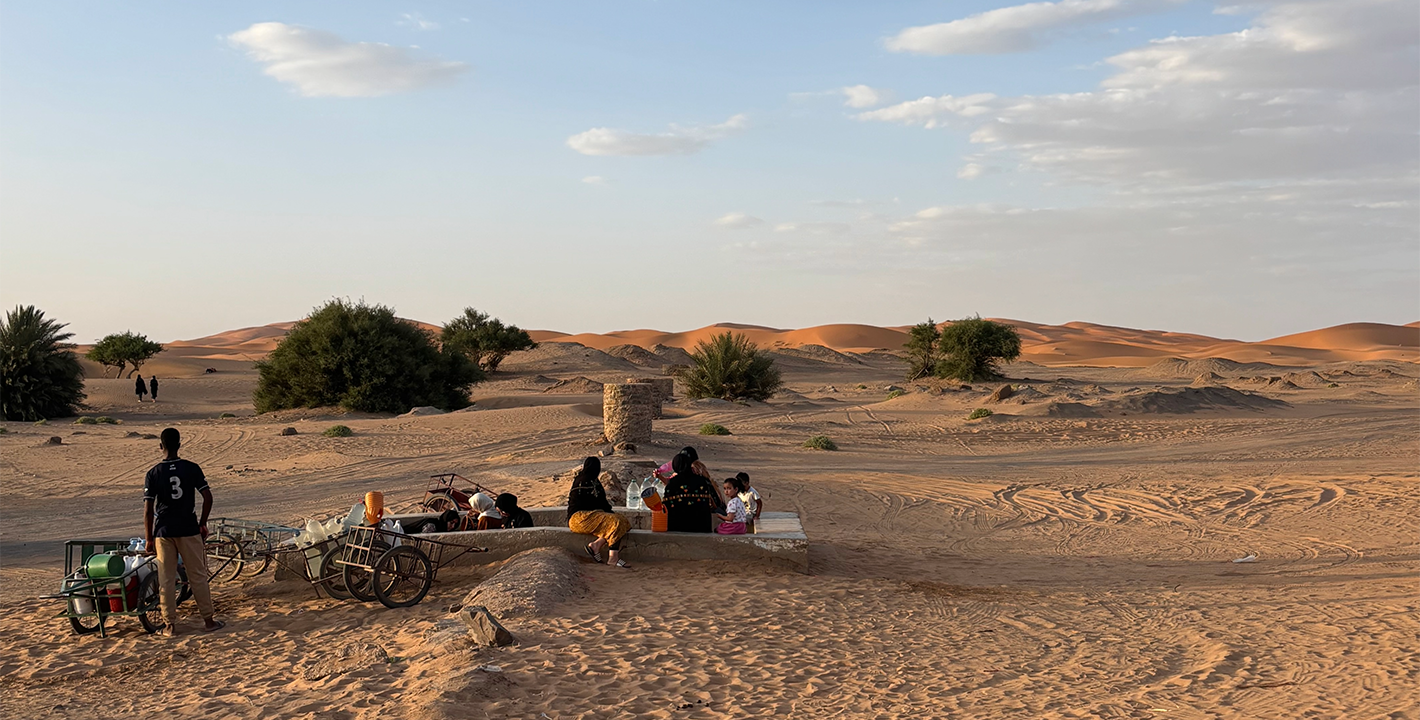Climate change is not only altering environments but also reshaping the patterns of everyday life. Among the Ait Khabbash communities in the Draa-Tafilalet oases of southeastern Morocco, women are at the heart of this transformation. As rising temperatures and irregular rainfall exacerbate water scarcity, women have had to deal with both the visible and invisible consequences of ecological change—from longer journeys to find water to the erosion of social worlds once sustained by nomadic traditions.
In Draa-Tafilalet, climate change is visible in multiple ways: multiyear droughts, erratic downpours, and drying aquifers. Oasis agriculture is particularly threatened, with date palms yielding less, even as they are more vulnerable to disease. The traditional infrastructures that had sustained communities, such as the khettara system, a communal network of underground canals that channels groundwater to fields, which was once the backbone of irrigation and social life, are decaying as motorized pumps deplete water tables. In 2017, Zagora’s “thirst protests” made this precarity visible. Residents took to the streets demanding their right to drinking water, prompting reforms in water distribution and investments in infrastructure from the state. As national policies lean on implementing big supply fixes, through desalination projects, dams, and inter-basin transfers, alongside governance reforms such as banning water-intensive crops, everyday life is being significantly altered in the oases and in local economies built around water scarcity—pressures that land hardest on women.
For generations, the women of Ait Khabbash were integral to the rhythms of nomadic life. Moving with their families and herds across semi-arid plains, they participated in a variety of tasks, including fetching water, herding animals, weaving, and maintaining tents. These daily practices fostered deep networks of solidarity and interdependence. Work was rarely solitary. Mostly, it was a communal act that sustained both bodies and bonds. Through shared routines, women cultivated mutual support and a collective sense of belonging rooted in mobility and cooperation.
Today, those patterns are shifting dramatically. The decline of nomadism, accelerated by desertification and dwindling water resources, has led many families to settle in villages. Sedentarism, intensified by desertification and diminishing water, has coincided with higher poverty rates and unequal access to services such as schooling or healthcare, pushing families off their ancestral lands.
While sedentarism brings certain conveniences, such as access to schools and markets, it also disrupts longstanding ways of life and significantly alters the division of labor. For women, the move to fixed settlements has often meant reduced mobility and heavier domestic burdens. Water sources are increasingly distant, and as groundwater levels drop the task of collecting water, still largely conducted by women, grows more exhausting and time-consuming. Additionally, when men leave for seasonal work outside the village, women are left to carry on domestic chores, care work, and procuring water.
In light of this, the social fabric that once emerged through collective labor is unraveling. The sense of togetherness born from working side by side is being replaced by isolation. Where women once met at wells or during seasonal migrations, they now perform household tasks alone, behind walls that protect but also confine. These physical changes mirror broader social transformations, where cooperation has given way to fragmentation and communal resilience has been weakened.
One of the older women who now lives in Marrakesh commented on the nostalgia felt by her peers: “We miss meeting each other, spending time together and working together. We used to sit under an acacia tree and make sksu [a traditional Moroccan dish] using tiwiza’.” Another woman, in her early thirties, who first moved with her husband to Ouarzazate and then Marrakesh, described missing the open spaces of the desert, hearing her language, and local produce such as barley and spices, notably cumin and henna, as well as dates, which she asks her brothers to bring with them whenever they visit. This longing for the rhythms of nomadic life—the unconstrained landscapes, shared laughter, and sense of purpose that came from living in harmony with the land—is shared by many others as well, revealing a profound emotional landscape. The memories of these women underscore the connections between environmental degradation and migration from ancestral lands to urban spaces, highlighting the repercussions on cultural and emotional aspects of life. The loss of mobility and communal connection marks a rupture in identity, leaving many women caught between past traditions and uncertain futures.
In Ait Khabbash, migration and sedentarization, whether a result of climate change, environmental decline, or socioeconomic factors, thus reveals itself to be a deeply gendered crisis. Women experience the burden of environmental degradation not only through physical labor but also through emotional and social loss. Their stories remind us that adaptation cannot be measured solely in infrastructure, largescale fixes, or policy terms. A holistic approach to sustainable responses must foreground gendered experiences to encompass not only heavier burdens on women but also uncertain futures marred by confinement and fragmented social bonds. Foregrounding women’s experiences in responses to climate change means recognizing that resilience is as much about rebuilding relationships and cultural continuity as it is about securing water and livelihoods.




